Aerosol characterisation including oxidative potential as a proxy of health impact
A case of a residential site in a highly industrialised area
DOI:
https://doi.org/10.17159/caj/2019/29/2.7517Keywords:
carbon, ions, acellular assays, cascade impactors, aeth, aethalometerAbstract
This study aimed to characterise aerosols sampled in the vicinity of a major industrialised area, i.e. the Vaal Triangle. It included the
determination of oxidative potential as a predictive indicator of particle toxicity. Aerosol samples were collated through the cascade
filtering during an eight-month period (12 h over three days in one week). Three size fractions were analysed for organic carbon
(OC), black carbon (BC) and oxidative potential (OP), while ionic content was presented as monthly and seasonal concentrations. The
continuous measurement of black carbon by an optical attenuation instrument was collated concurrently with cascade filtering. The
carbonaceous content was low compared to the ionic one. Within the carbonaceous concentrations, the organic carbon was higher
than concentrations of black carbon in both seasons in the ultra-fine fraction; the opposite was the case for the fine fraction, while
the coarse fraction concentrations of organic carbon in the dry season had higher concentrations than black carbon in the wet season
and organic carbon in the wet season. The OP tended to increase as the size was decreasing for wet season aerosols, whereas, for
the dry season, the highest OP was exerted by the fine fraction. The ultrafine fraction was the one showing the most contrasting OP
between the two seasons. Continuous monitoring indicated that the higher BC concentrations were recorded in the dry/winter part
of the year, with the daily pattern of concentrations being typically bimodal, having both the morning and evening peaks in both
seasons. Within the ionic content, the dominance of sulphate, nitrate and ammonium was evident. Multiple linear correlations were
performed between all determined compounds. Strong correlations of carboxylic acids with other organic compounds were revealed.
These acids point to emissions of VOC, both anthropogenic and biogenic. Since they were equally present in both seasons, a mixture
of sources was responsible, both present in the wider area and throughout the year.
Downloads
Downloads
Published
Issue
Section
License
Copyright (c) 2019 Miroslav Josipovic

This work is licensed under a Creative Commons Attribution 4.0 International License.

All articles are published under a Creative Commons Attribution 4.0 International License; copyright is retained by the authors. Readers are welcome to reproduce, share and adapt the content without permission provided the source is attributed.








.png)